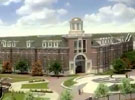Colleges Design New Housing to Engage and Retain Students
The concept for the new Residential Commons was derived from higher learning institutions overseas.

By Caitlin Peterkin
Knute Axelbrod, 64, starts college lonely in a short story by Sinclair Lewis. "Lacking the stimulus of friendship, it was the harder for Knute to keep up the strain of studying the long assignments." He eventually meets a classmate and shares an evening of history, music, and poetry, devouring "all the art of life he had come to college to find."
That tale represents an ideal for colleges' residential renovations, efforts to engineer the sort of engagement Knute achieves. A copy of the story was given to an architect before he began work on Franklin & Marshall College's house system, which hoped to evoke such spirit.
With goals of fostering an intellectual atmosphere, building relationships, and increasing students' involvement on campus—and, ultimately, their rates of retention—universities around the country, including Elon, Michigan State, and Southern Methodist, are looking to residence life. House systems, residential neighborhoods, and living-learning programs, they hope, will connect students' learning in and out of class.
The idea is to make a campus feel more intimate and to promote a seamless student experience. . .
Construction is under way at Southern Methodist, which calls its development the Residential Commons. It features five new complexes, in addition to existing residence halls, and is scheduled to open in the fall of 2014. Students will be required to live on campus for their first two years rather than one year, as is now the case.
The university will encourage students and live-in faculty members to establish an identity for their houses through events and traditions, building a sense of community, says Lori S. White, vice president for student affairs.
Read the full story. (Subscription may be required.)
From SMU Magazine
Residential Commons:
Transforming The On-Campus Living Experience
By Lauren Smart ’11

The freedom of living away from my parents on the scenic SMU campus was exciting, with a constant influx of new friends and activities. However, soon I began wishing for my first apartment in Dallas and couldn’t wait to have my own kitchen and bathroom. But moving off campus was jarring.
If you hadn’t found an apartment by the end of freshman year, you were already behind, as accommodations near campus were swept up long before May. Although some residential hall rooms are available to upper-class students who choose to remain on campus, beginning their sophomore year, many students as young as 19 commute to campus from Uptown, the Village or other nearby areas. I became an efficient grocery shopper, adjusted to a neighborhood without campus staff or police and navigated traffic and parking to get to class on time.
But this scenario will change in 2014 with the completion of five new residence halls in the southeast corner of campus. They will be part of the Residential Commons, along with all other residence halls retrofitted to that model. And SMU will require sophomores to live on campus, in addition to first-year students.
Derived from the model that originated at higher learning institutions overseas, particularly Oxford and Cambridge, the Residential Commons can be most familiarly compared to Harry Potter’s Hogwarts. Although there will be no ceremonial “sorting hat,” all room assignments will be random. Faculty members will live in apartments tucked into the residence halls, relationships with a particular hall will last an entire academic career, there will be classrooms in each hall, and students will be encouraged to participate in activities with their residential neighbors.
“The idea is that each Commons will be a microcosm of the campus as a whole,” says Lori White, vice president for student affairs. “We want to avoid the stereotypes that X-type of student lives here and Y-type of student lives there.”